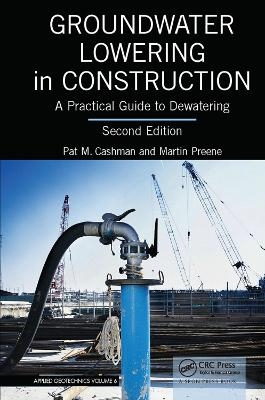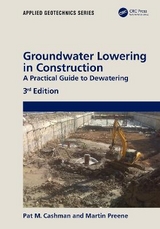
Groundwater Lowering in Construction
Routledge (Verlag)
978-1-138-07730-0 (ISBN)
- Titel erscheint in neuer Auflage
- Artikel merken
Discover engineering methods that can help you improve working conditions, increase project viability, and reduce excavation costs.
In the decade since publication of this book’s first edition, groundwater lowering and dewatering activities have been increasingly integrated into the wider ground engineering schemes on major excavations to help provide stable and workable conditions for construction below groundwater level. Consequently, many engineering ventures now require a more in-depth assessment of potential environmental impacts of dewatering and groundwater control, and this book details the latest best practices to evaluate and address them.
Includes New Chapters Covering:
Cutoff methods used for groundwater exclusion
Issues associated with permanent or long-term groundwater control systems
Groundwater control technologies used on contaminated sites
Methods needed to understand, predict, and mitigate potential environmental impacts of groundwater control works
Updated to reflect the crucial technological and application advances shaping construction processes, this book contains valuable direction that can give you a true competitive advantage in the planning and execution of temporary and permanent dewatering works. The authors cover cutting-edge methods and key subjects, such as the history of dewatering, working on contaminated sites, site investigation techniques, and operation and maintenance issues, including health, safety, and legal aspects. Written for practising engineers and geologists as well as postgraduate engineering students, this updated manual on design and practice provides numerous case histories and extensive references to enhance understanding.
Prior to his death in 1996, Pat Cashman was the leading British exponent of groundwater control for his generation. For more than 40 years, during the growth of soil mechanics into the practice of geotechnical engineering, Pat was responsible—through the organisations he ran, and later as a consultant—for maintaining a practical and straightforward approach to the art of groundwater control. Dr. Martin Preene is a highly experienced geotechnical engineer specializing in groundwater engineering and hydrogeology. Martin has more than 25 years of experience working with contractors and consultants on the design and implementation of dewatering and groundwater control systems. He has worked on major engineering projects around the world, including power stations, road and railway tunnels, dry docks, and open-pit mines. He is widely published on dewatering and groundwater engineering, including papers and industry guidance documents. Dr. Preene is currently a principal at Golder Associates in the UK.
Groundwater lowering: A personal view, P.Cashman
Structure of the rest of the book
History of groundwater theory and practice
Earliest times to the sixteenth century
Renaissance period to the nineteenth century
Progress from a qualitative to a quantitative science
Later theoretical developments
Groundwater modeling
Early dewatering technology in Britain
Practical publications
Groundwater and permeability
Hydrology and hydrogeology
Permeability and groundwater flow
Aquifers, aquitards, and aquicludes
Flow to wells
Aquifers and geological structure
Aquifer boundaries
Using geological structure to advantage
Groundwater chemistry
Groundwater effects on the stability of excavations
Groundwater control—the objectives
Groundwater, effective stress, and instability
Large-scale instability caused by groundwater
Slope instability
Base instability
Localized groundwater problems
Excavations in rock
Surface water problems
Effect of climate and weather
Methods for control of surface water and groundwater
Control of surface water
Methods of groundwater control
Exclusion methods
Dewatering methods
Groundwater control for tunnels and shafts
Use of pumping and exclusion methods in combination
Site investigation for groundwater lowering
Purpose of site investigation
Planning of site investigations
Stages of site investigation
Determination of ground profile
Determination of groundwater conditions
Determination of permeability
Design of groundwater lowering systems
What is design?
Design approach
Development of a conceptual model
Expectations of accuracy
Selection of method and geometry
Estimation of steady-state discharge flow rate
Specification of well yield and spacing
Other considerations
Numerical modeling
Sump pumping
Applications of sump pumping
Pumping of surface water runoff
Pumping sumps
Drainage of side slopes of an excavation
Sump pumping of small excavations
Sump pumping problems
Disposal of water from sump pumping operations
Case history: Sump pumping of large excavation
Wellpoint systems
Which system: Wellpoints or deep wells?
What is a wellpoint system?
Wellpoint installation techniques
Spacing of wellpoints and drawdown times
Sealed vacuum wellpoint system
Wellpoint pumping equipment
Wellpoint installations for trench excavations
Wellpointing for wide excavations
Wellpointing for deeper excavations
Case history: Derwent outlet channel, Northumberland
Deep well systems
Deep well installations
Design of wells for groundwater lowering
Constructing deep wells
Drilling of well boreholes
Installation of well materials
Well development
Installation and operation of deep well pumps
Vacuum deep well installations
Shallow well installations
Case history: Tees barrage, Stockton-on-Tees
Other dewatering systems
Ejectors
Horizontal wellpoints
Horizontal wells
Pressure relief wells
Collector wells
Siphon drains
Electro-osmosis
Artificial recharge systems
Dewatering and groundwater control technologies used for the control or remediation of contaminated groundwater
Methods for the exclusion of groundwater
Principal methods for groundwater exclusion
Geometries of exclusion applications
Steel sheet piling
Vibrated beam walls
Slurry trench walls
Concrete diaphragm walls
Bored pile walls
Grout barriers
Mix-in-place barriers
Artificial ground freezing
Pumps for groundwater lowering duties
Wellpoint pumps
Jetting pumps
Sump pumps
Pumps for deep wells
Sizing of pumps and pipework
Permanent groundwater control systems
Types of permanent groundwater control systems
Objectives of permanent groundwater control systems
Design issues for permanent groundwater control systems
Practical issues for permanent groundwater control systems
Opportunities associated with permanent groundwater control systems
Case history: Govan underground tunnel, Glasgow
Environmental impacts from groundwater control
Why are impacts from groundwater control of concern?
Potential environmental impacts from groundwater control
Impacts from groundwater abstraction
Impacts from groundwater pathways
Impacts from groundwater barriers
Impacts from discharge flows to the groundwater environment
Impacts from discharge flows to the surface water environment
Assessment of potential environmental impacts
Monitoring and maintenance of groundwater lowering systems
Need for monitoring
Monitoring of water levels
Monitoring of discharge flow rate
Other parameters that may be monitored
Data-logging systems
Mechanical factors and automation
Backfilling and sealing of wells on completion
Encrustation, biofouling, and corrosion
Fault finding and problem solving
Safety, contracts, and environmental regulation
Health and safety
Contracts for groundwater control works
The future—a personal perspective by Toby Roberts
Applications and techniques
Communication and monitoring technology
Numerical modeling
Regulation
Where do we go from here?
Next generation of dewatering practitioners
Appendix 1: Estimation of permeability from laboratory data—Loudon method
Appendix 2: Execution and analysis of variable head permeability tests in boreholes
Appendix 3: Execution of well pumping tests
Appendix 4: Design examples
Appendix 5: Estimation of flow rate using V-notch weirs
List of notation
Glossary
List of conversion factors
References
| Erscheinungsdatum | 01.07.2017 |
|---|---|
| Zusatzinfo | 87; 36 Tables, black and white; 225 Illustrations, black and white |
| Verlagsort | London |
| Sprache | englisch |
| Maße | 156 x 235 mm |
| Gewicht | 454 g |
| Themenwelt | Technik ► Bauwesen |
| Technik ► Bergbau | |
| ISBN-10 | 1-138-07730-5 / 1138077305 |
| ISBN-13 | 978-1-138-07730-0 / 9781138077300 |
| Zustand | Neuware |
| Informationen gemäß Produktsicherheitsverordnung (GPSR) | |
| Haben Sie eine Frage zum Produkt? |
aus dem Bereich



